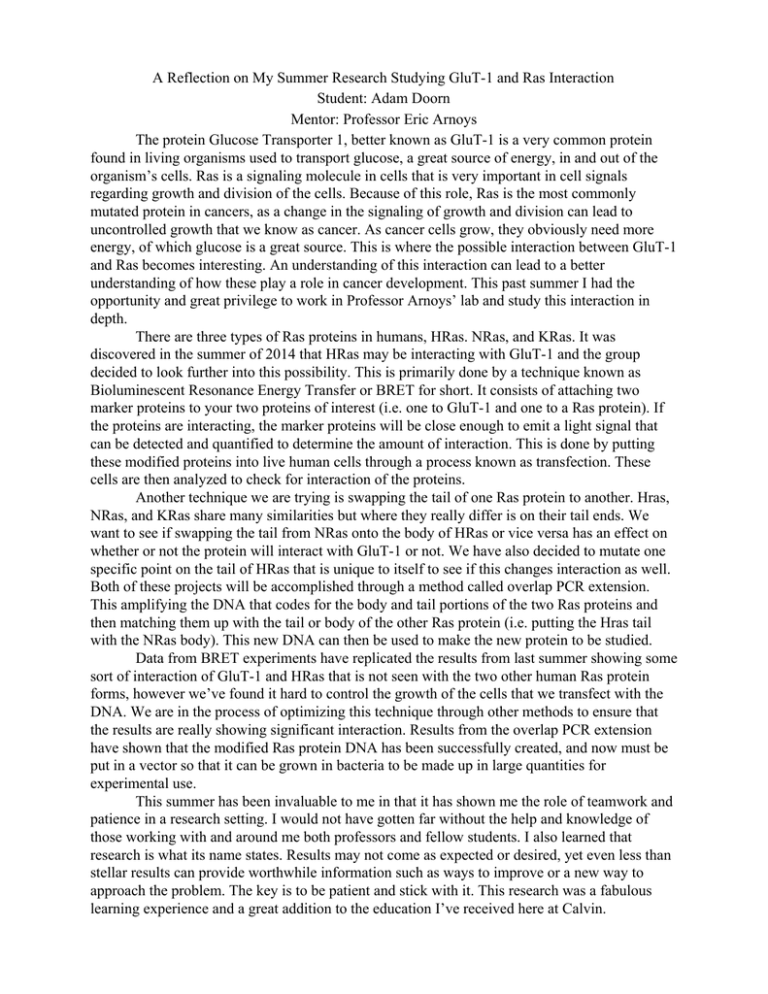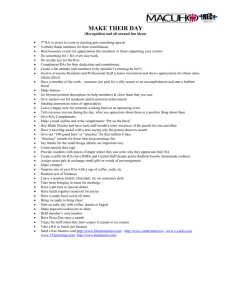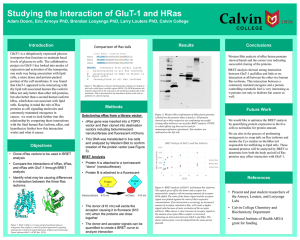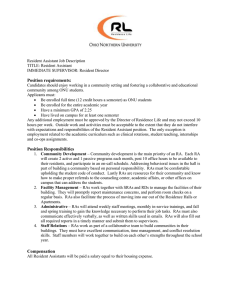A Reflection on My Summer Research Studying GluT1 and Ras Interaction Student: Adam Doorn Mentor: Professor Eric Arnoys
advertisement

A Reflection on My Summer Research Studying GluT­1 and Ras Interaction Student: Adam Doorn Mentor: Professor Eric Arnoys The protein Glucose Transporter 1, better known as GluT­1 is a very common protein found in living organisms used to transport glucose, a great source of energy, in and out of the organism’s cells. Ras is a signaling molecule in cells that is very important in cell signals regarding growth and division of the cells. Because of this role, Ras is the most commonly mutated protein in cancers, as a change in the signaling of growth and division can lead to uncontrolled growth that we know as cancer. As cancer cells grow, they obviously need more energy, of which glucose is a great source. This is where the possible interaction between GluT­1 and Ras becomes interesting. An understanding of this interaction can lead to a better understanding of how these play a role in cancer development. This past summer I had the opportunity and great privilege to work in Professor Arnoys’ lab and study this interaction in depth. There are three types of Ras proteins in humans, HRas. NRas, and KRas. It was discovered in the summer of 2014 that HRas may be interacting with GluT­1 and the group decided to look further into this possibility. This is primarily done by a technique known as Bioluminescent Resonance Energy Transfer or BRET for short. It consists of attaching two marker proteins to your two proteins of interest (i.e. one to GluT­1 and one to a Ras protein). If the proteins are interacting, the marker proteins will be close enough to emit a light signal that can be detected and quantified to determine the amount of interaction. This is done by putting these modified proteins into live human cells through a process known as transfection. These cells are then analyzed to check for interaction of the proteins. Another technique we are trying is swapping the tail of one Ras protein to another. Hras, NRas, and KRas share many similarities but where they really differ is on their tail ends. We want to see if swapping the tail from NRas onto the body of HRas or vice versa has an effect on whether or not the protein will interact with GluT­1 or not. We have also decided to mutate one specific point on the tail of HRas that is unique to itself to see if this changes interaction as well. Both of these projects will be accomplished through a method called overlap PCR extension. This amplifying the DNA that codes for the body and tail portions of the two Ras proteins and then matching them up with the tail or body of the other Ras protein (i.e. putting the Hras tail with the NRas body). This new DNA can then be used to make the new protein to be studied. Data from BRET experiments have replicated the results from last summer showing some sort of interaction of GluT­1 and HRas that is not seen with the two other human Ras protein forms, however we’ve found it hard to control the growth of the cells that we transfect with the DNA. We are in the process of optimizing this technique through other methods to ensure that the results are really showing significant interaction. Results from the overlap PCR extension have shown that the modified Ras protein DNA has been successfully created, and now must be put in a vector so that it can be grown in bacteria to be made up in large quantities for experimental use. This summer has been invaluable to me in that it has shown me the role of teamwork and patience in a research setting. I would not have gotten far without the help and knowledge of those working with and around me both professors and fellow students. I also learned that research is what its name states. Results may not come as expected or desired, yet even less than stellar results can provide worthwhile information such as ways to improve or a new way to approach the problem. The key is to be patient and stick with it. This research was a fabulous learning experience and a great addition to the education I’ve received here at Calvin.





